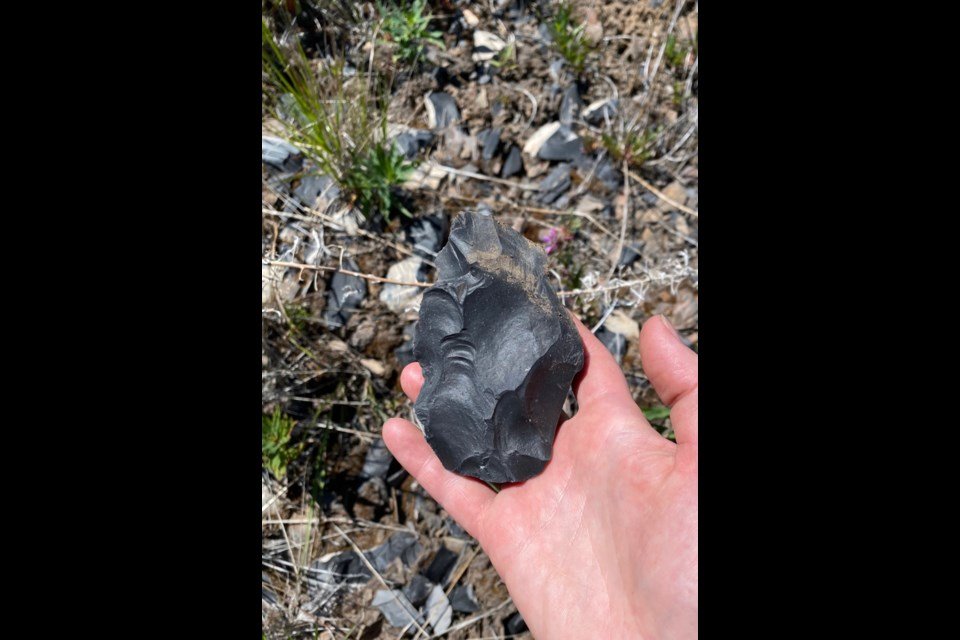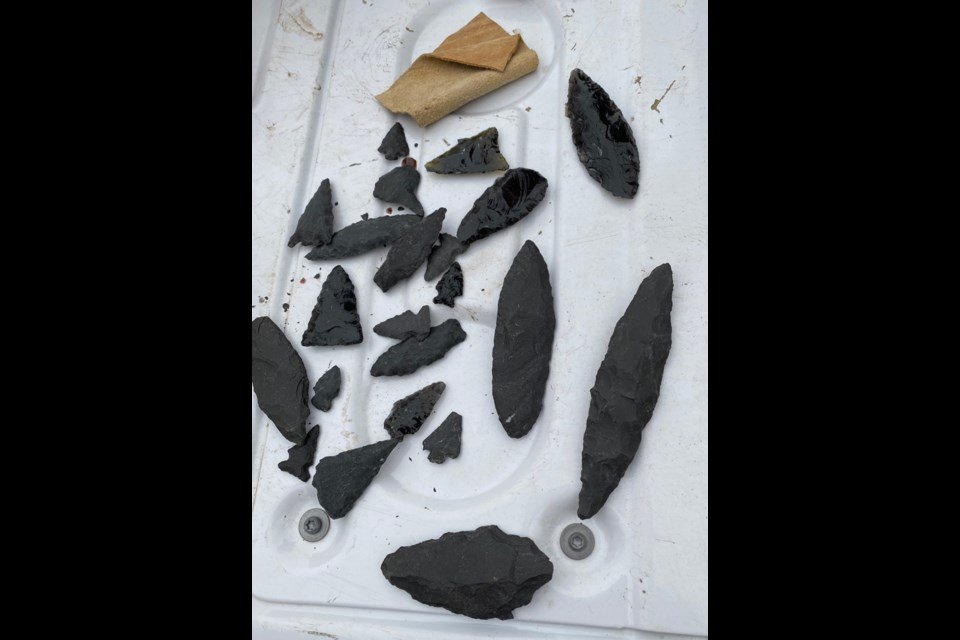The Arrowstone Hills have been used as a source of stone for manufacturing tools by the Secwépemc and Nlaka’pamux for more than 12,000 years.
The hills are located northeast of the Cache Creek and north of the Thompson River, between the Bonaparte and Deadman rivers.
The Secwépemc have an oral history about the transformer, Tlli7sa, and his brothers, who in a fight with Grizzly Bear sisters, shook loose the shards of stone from their spiky fur. Those shards were cast around Arrowstone Hills for subsequent generations to find.
Volcanism in this area occurred approximately 56 to 47 million years ago and resulted in the formation of volcanic deposits rich in silicious fragments of a rock type known as dacite.
Arrowstone Creek, a major confluence of Cache Creek (the waterway), subsequently dissected through one of these volcanic deposits, which resulted in pebbles, cobbles and small boulders of dacite being spread over the landscape.
Known dacite exposures cover an area measuring approximately 100 square kilometers and could extend even further.



The quarry sites within the Arrowstone Hills are unique in that arduous methods of stone removal were not required. Unlike many other prehistoric quarry sites, the material was found on the ground surface or just below it.
One of the quarry sites has an astonishing 115 pits where the dacite rocks were mined from the ground.
Instead of hauling large rocks off the mountain, stone tool technicians would knapp (chip) pieces off at the quarry site, leaving behind what are referred to as reduction flakes. They would also make rough tool shapes called blanks or preforms, which they could later knapp into more specialized tools or use for trade.
At the quarry sites, the ground is covered with thousands of these pieces, in some places as thick as two metres. The Arrowstone Hills material is very good for knapping stone tools. This made the material extremely valuable and, as a result, it was traded extensively.
Archaeologists can learn about trade routes by tracing this material. First, the material must be “fingerprinted,” which can be done by analyzing the mineral and geochemical composition of the rocks at these quarry sites. Figuring out where the stone tools that we find originate allows for a much broader understanding of cultural exchanges.
Historically, the source materials of obsidian tools have been easier to identify and have been a focus of previous archaeological research, but now, silicate toolstone datasets are growing.
This is due to the greater availability and portability of equipment used in geochemical analyses and modern ways of sharing knowledge, such as the internet and open source software.
Recently, nine projectile points recovered from the YaçkEtEl site, a Coast Salish-Sts’ailes site on the Harrison River, located approximately 200 kilometers away, were geochemically analyzed and attributed to Arrowstone Hills.
As more of the stone tool material is correctly identified and geochemically analyzed, and as more source locations are “fingerprinted,” this number is going to grow and reveal more information about ancient interaction spheres and trade.
I was fortunate to visit Arrowstone Hills recently with Bert William, a member of Bonaparte First Nation and archaeologist with SNRC. Bert and his brother, JR William, discovered several of the quarry sites while surveying the landscape before it burned in the 2017 Elephant Hill fire. Bert is also a skilled knapper.
Although the stone tools Bert knapps are no longer used for hunting and processing, it speaks to the culture local Indigenous people are still sourcing dacite at Arrowstone Hills and keeping this tradition alive.
Sadly, Bert said he does not see a lot of interest from younger generations in carrying out this tradition. It is a skill that takes countless hours of practise to perfect.
Maybe as more archaeologists study the “fingerprints” of these materials, this will help foster a greater interest in knapping stone tools. As an archaeologist, learning to knapp provides valuable knowledge in understanding the manufacturing of stone tools and how sites are formed.
Bert has become one of my greatest mentors and I am grateful to learn knapping skills from him.
Katie Sperry is a Kamloops-based archeologist.

